Mudlarks at Home
© London Museum
Step inside the mini museums curated by Thames foreshore foragers
London Museum (Docklands) is holding the UK’s first major exhibition dedicated to mudlarking: Secrets of the Thames. Until March 2026, visitors can unearth fascinating objects and stories from London’s past and explore the hidden world of mudlarks, from the enterprising scavengers who scoured the muddy river foreshore for dropped pieces of coal to present-day amateur mudlarks who forage for fascinating finds in their spare time.
Victorian false teeth, Elizabethan silver sixpence love tokens, Tudor shoes and hair combs decorated with dancing phalluses – the exhibition is a showcase of the weird and wonderful objects that have turned up with the tides.
As well as giving us compelling glimpses into history via carefully-curated artifacts, Secrets of the Thames attempts to convey the passion of the mudlarks for their river rituals and beautifully highlights the deeper, spiritual aspect of the process. Mudlarking is presented as a peaceful retreat from city life to an other-worldly realm of treasures and tides where the moon is worshipped, time is as fluid as water and you can – literally – touch the past.
To celebrate the exhibition, Reclaim has peeped inside the homes of five leading mudlarks, where they curate, display and study their finds. These mini museums tell us so much about their personalities, their mudlarking styles and how their finds connect them to the past…
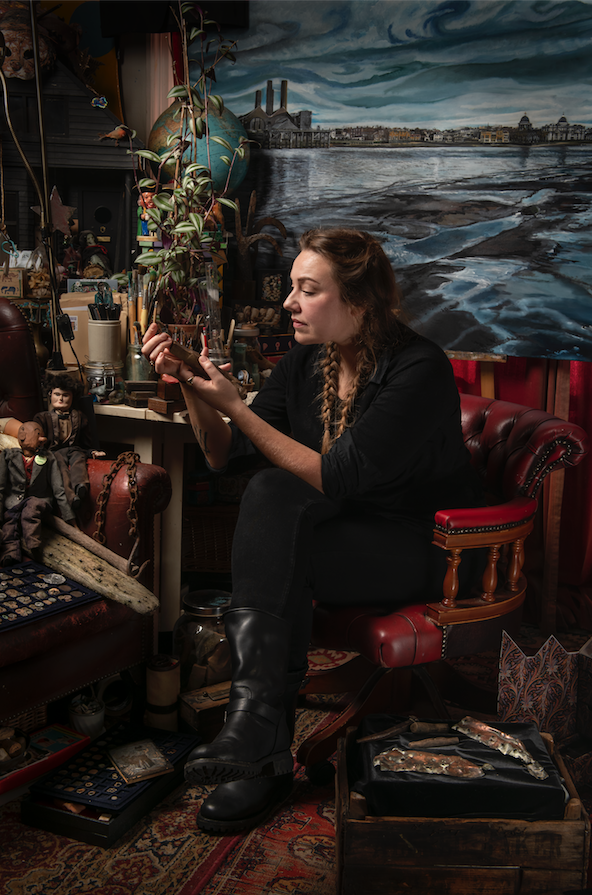
Marie Lousie Plum © London Museum
Marie Louise Plum
‘I’ve always been transfixed by searching – whether in old bookshops, junk shops or abandoned buildings. I like using an object or a place to find stories. I watched the TV series Mud Men on the History Channel with Steve Brooker and joined his mudlarking group: Thames and Field. I was instantly hooked. You never know what you’re going to find. I’ve been mudlarking for ten years now.
It’s hard to choose favourites, but there are a few finds I really treasure; I have a pilgrim badge from Rome which dates from 1400-1500. It’s a trinket that would have been brought back to London and then either lost or thrown into the river as an offering. I also have half a medieval cooking cauldron and a cufflink with the bust of Marie Antoinette’s mother on it, which I absolutely love.
I’m also drawn to the humble everyday objects that were the personal effects of regular everyday Londoners. Dress pins that were made by hand, drinks bottles, wig curlers, Roman pottery sherds, a roof tile with a dog’s paw print in it…the objects I find unlock stories and show me that the past is not a far off place. People 600 years ago were doing the same things we still do today, albeit in a slightly different way.
Objects were cocooned in the mud and preserved, so when they come out they start to degrade. I keep them carefully packed away but three or four times a year, I display my finds in the Hands On History exhibitions – we’re @handsonhistorymudlarks on Instagram.
I find lots of devotional offerings – both old and modern. In 1970, the river was blessed and is considered by Hindis to be an extension of the Ganges. I once found a beautiful figurine of Kali, the Hindu goddess of change. She’s quite ferocious looking – I really identify with her!
The Thames holds the secrets of so many people who have lived in London or passed through London. People live on the river, die in the river – it’s full of ghosts and I see it like a huge, silent but present artery that runs through the city. I’m an artist and I write, but mudlarking has become inter-twined with everything else that I do. When it’s low tide and you’re seven metres down, on the river bed, it’s a strange zone. It feels like another world – a magical place.’
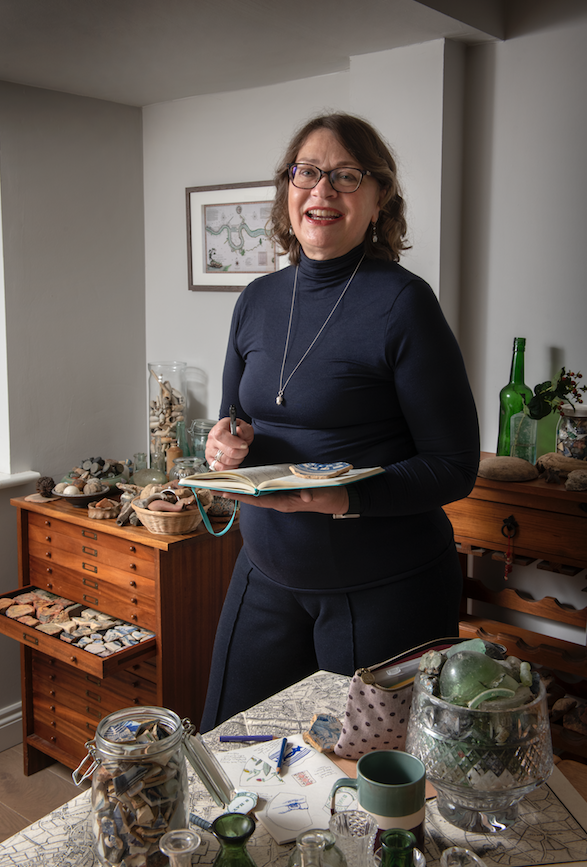
© London Museum
Liz Anderson
‘Ten years ago, on a gloomy January day, I was walking along the Southbank in London and noticed some steps going down to the foreshore. The tide was out and I saw a mudlark. We got chatting and he said the river is like a liquid carpet that rolls back twice a day and leaves historical artefacts. I looked down at my feet and spotted my first find – a fabulous sherd of tin-glazed blue and white Delftware pottery. It was a tiny fragment of history – part of a plate with beautiful ferns and flowers on it. That was it. I had fallen down a rabbit hole – I was touching something that hadn’t been held for 300 years.
It’s addictive. You lose yourself when you’re mudlarking and forget about everything else. London is so hectic with everybody buzzing about like bees, but down on the foreshore, time really does stand still.
I studied History at university, but it was very formal – all kings and queens, power and politics. Mudlarking is a more relaxed mix of Thames archaeology and history. You hold objects in your hands that were owned by people long ago, whose names you’ll never know, but through handling the items they touched and lost, you bring them back to life in a way.
I keep a notebook of all my finds. I’ve found pottery from Roman times right through to Victorian times. If I’m feeling anxious, I get out my notebooks and colouring pencils and draw a pottery sherd. I handle it, focusing on the shape, the form and the feel. I trace around it, colour it in and make some notes. Research is at the heart of mudlarking.
I have a bucket in the garden for cleaning finds. I use sterilising tablets or just hot, soapy water. A toothbrush helps to remove any encrusted mud.
Having my own mini museum at home is part of the fun for me. As the curator, I’m proud and a bit possessive. My finds are kept in a special cabinet which used to belong to a lepidopterist, so the shallow drawers are perfect for finds. I have beads in one drawer, coins in another, pottery in the lower drawers, all arranged by era. Larger items like poison and apothecary bottles are on top. I keep clay pipes in a large glass vase, fossils in bowls. I’m always looking for lead type trays, vintage dishes and display cases on eBay and charity shops. I’m a bit OCD. Nobody is allowed near my finds! But they’re stored in our dining room and when we have guests over for dinner, I take objects out and we have a little show and tell.
I curate carefully. I don’t keep everything. If I have too much Victorian Willow pattern china or 18th Century slipware, sometimes I take things back to the river, so I’m not overwhelmed by my collection. Returning finds is a little ritual. I put them back where I found them, so another mudlark can find them.’
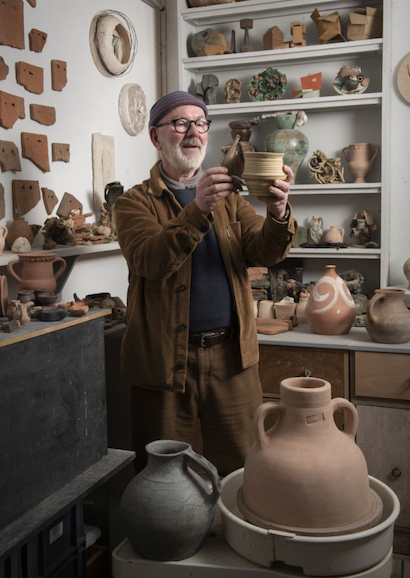
© London Museum
Mark Sowden
‘I first went down on the foreshore seven years ago and since then I’ve been down 420 times. Mudlarking is addictive because the moment of discovery is so exciting. There is a real skill to searching and you have to put in the hours. Sometimes I don’t find anything of note. Mostly, objects I do find need a bit more research. I see it as a whole process – searching, finding, cleaning, researching.
I worked as a sculpture technician in an art school for 34 years, so my whole world has been focused on the visual. Because of my background, when I go down to the foreshore, I’m more attuned than some to the materiality. I’m particularly interested in pottery. I find fragments and broken things so I have to imagine what the whole object might have looked like.
I take small pieces of pottery and turn them on a turntable, photographing them digitally to generate an impression of the original form. Mudlarking has also reignited my interest in working with clay – I make replica items, for example Roman oil lamps and vessels – using my finds as a starting point.
As a maker myself, it’s so important to me to be able to touch my finds, turn them over, feel the weight of them and put my fingers exactly where somebody else did 1800 years ago – it gives me an amazing sense of connection to the past and allows me to ‘tune in’ to past makers.
There’s a weird sense that the river is gifting us these things. When something presents itself to you down there and you’re the first person to see it – it’s an encounter and feels like an offering. The river environment is not static like a ploughed field where metal detectorists hunt. The foreshore reveals itself bit by bit as the tide goes out, then gradually the tide creeps back in and pushes us off. The tide rearranges things a bit – pushes and pulls everything, so next time you go down it’s laid out slightly differently. It’s like dealing with a live, active force. We all have massive respect for the river – it can be a dangerous environment, but it’s also a giving and generous one.
I display my finds in my studio at home, which is also my workshop space. I commissioned a furniture maker to create a bespoke chest of drawers for me to store my most precious finds in. I am constantly moving things around and curating my objects in different ways. I have a drawer for tiny precious things – the really small stuff. The second drawer down is bone, iron, lead, copper – a pre-plastic materials palette. There’s nothing pretty in that one. It’s heavy, basic finds. Then I have chronological drawers with Roman finds, medieval finds, then Tudor, 17th Century…there’s a drawer for floor surfaces and tiles. The categories shift – they’re not fixed, they’re fluid. I have free reign to change anything at any time. Sometimes I put all the bone items together – I like mini curations that help me to make connections between finds and understand them more deeply. You become a much better mudlark (and maker) by giving your finds attention and spending time with them, getting to know them – cementing the forms and materials in your visual memory. I draw and photograph my finds, too. Sometimes I feel like an amateur archaeologist, but sometimes my attention is more like an artist.’
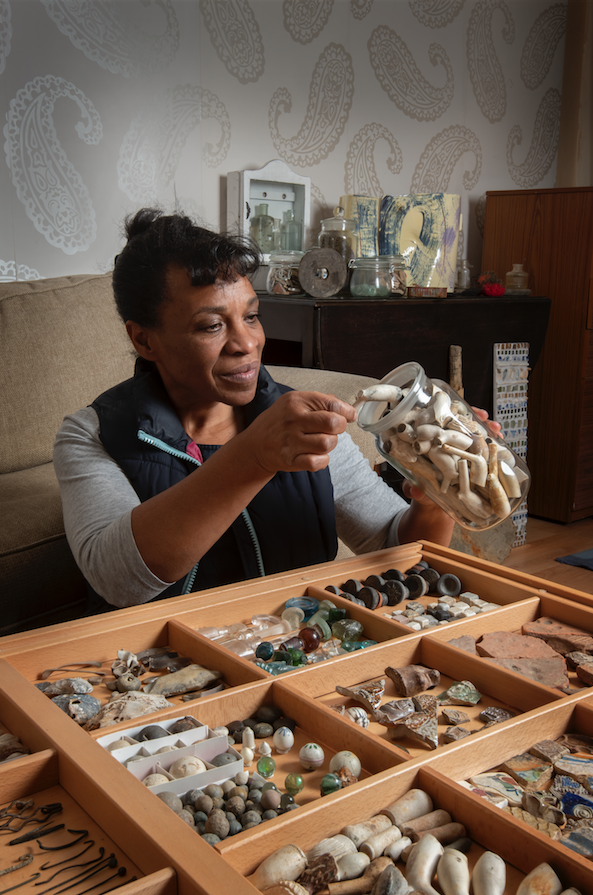
© London Museum
Fran Sibthorpe
‘As a child, I always loved exploring and playing in mud. We used to go to the Jurassic coast on holiday and I did a lot of fossil-hunting. A few years ago, I was eating in the riverside Prospect of Whitby pub in, when I noticed Pelican Stairs, that lead down to the foreshore. I walked along the mud and picked up some blue and white sherds. After that, I went on the Thames Discovery Programme, applied for a permit in 2017 and I’ve been mudlarking ever since.
You never know what you’re going to find when you go down there. It’s just nice to be able to wander on my own, or sometimes with a group of people – to have that moment, to focus on searching, exploring, discovering.
I love the river environment, too – I’ve shared the foreshore with seals, Canadian geese and goslings. I’ve had some beautiful experiences with wildlife while mudlarking.
I tend to look for the micro-finds, the smaller things that sometimes people miss. I get really, really low, kneeling down with my eyes very close to the ground. I have a few favourite finds, such as my Roman Intaglio and a bead I once found, which sort of transported me back to my ancestry. Another favourite find has got to be a mid-17th century trade token with a beautiful Noah’s Ark and dove design on it.
I keep a lot of my finds in a coffee table with a glass top. It’s a real talking piece. I like sharing my finds. I see myself as a custodian of them. I keep clay pipes in a big glass jar – they’re very common to find. I return ones I don’t need and try not keep duplicates.
I used pottery and glass sherds to make a mosaic on a big board, so I display some of my finds as art. I like to lose myself in my museum, adjusting finds, exploring them, rediscovering them.’
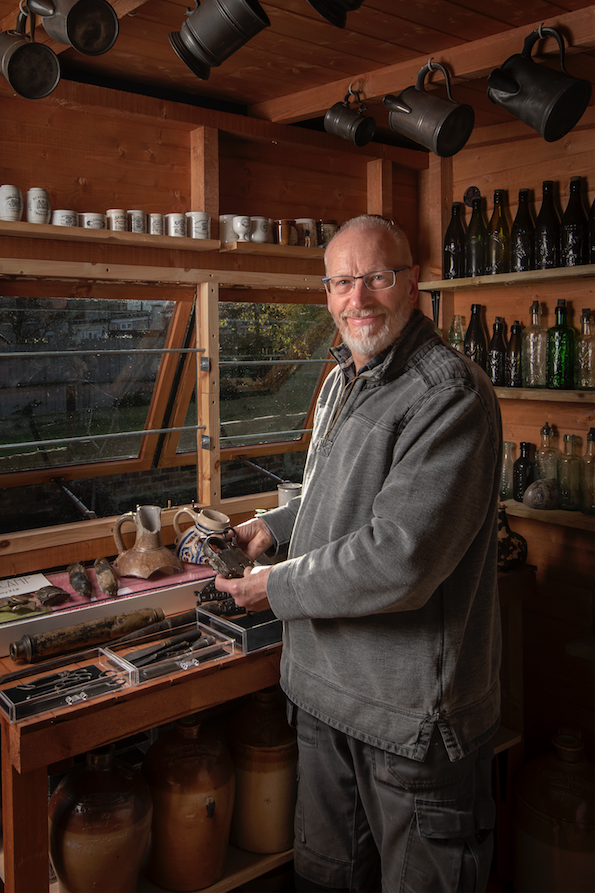
© London Museum
Steve Camp
‘I keep my finds in my ‘man cave’ – a shed in the back garden. I display my favourite pieces and keep a lot of stuff packed away in boxes, too. I’ve been mudlarking for over 20 years, so I’ve collected a lot of things.
I’m a member of the Society of Thames Mudlarks. There aren’t many perks, but it means you can go to slightly out of bounds areas that people with a standard permit can’t. I scour the surface with my eyes – I don’t do much scraping about with trowels.
It’s a bit like fishing – you never know what you’re going to catch! I’ve found stone age tools, Tudor gold, buttons, signet rings, buckles – so many fascinating things. It’s a popular hobby these days, so there’s a bit less stuff on the foreshore than there used to be and it’s a bit busier than it was years ago.
I particularly like metal finds. The Thames mud is anaerobic, so iron is preserved in it until it emerges at the surface. If you find metal items before they’re exposed to too many tides, you can restore them and get them back to how they were the day they were dropped. I like padlocks and, if it’s high tide, I enjoy bringing these finds back to life. I’ve got scissors, knives, keys – all sorts.
One of the most interesting and unusual things I’ve found is part of an early 19th Century ship’s telescope. The London Museum has recorded it recently. I thought it was a piece of copper pipe when I first saw it. It was only when I got closer that I realised it was a bit more important! It has a London maker’s name on it and it’s still got some lenses inside – perhaps it broke and was thrown overboard or maybe it was just dropped by accident.
Mudlarking is a cracking hobby and there’s a wonderful community of people in the realm, too. I love doing exhibitions in London, showing my finds and seeing everybody else’s while sharing my passion with members of the public. I’ve met so many brilliant people and I don’t know where I’d be without it, honestly. I’m just popping off to the river now, as the tide is low…’
- To mudlark on the Thames foreshore, you have to obtain a Foreshore Permit from the Port of London Authority, which costs an annual fee of about £75. Currently, there are no new licenses being issued.
- If you have a license and you find anything on the foreshore, you can keep it, but you have to report anything over 300 years old to the Portable Antiquities Scheme to record them.
- It is against the terms and conditions of a mudlark license to sell objects that are found on the foreshore. Licenses can – and have been – revoked when individuals violate the rules.
Before you go...
...fancy automatic entry to all future competitions?
Simply register online today for FREE and you will get:
Automatic entry to all current and future competitions.
Access to Reclaim Inspiration - an online visual pinboard for saving all your home and style inspiration.
A regular newsletter of inspiration, ideas and advice.

Save all your articles in one place
Become a Reclaim Member to save all your home and style inspiration. Simply login or register online today for FREE and you will get:
Automatic entry to all current and future competitions.
Access to Reclaim Inspiration - an online visual pinboard for saving all your home and style inspiration.
A regular newsletter of inspiration, ideas and advice.








